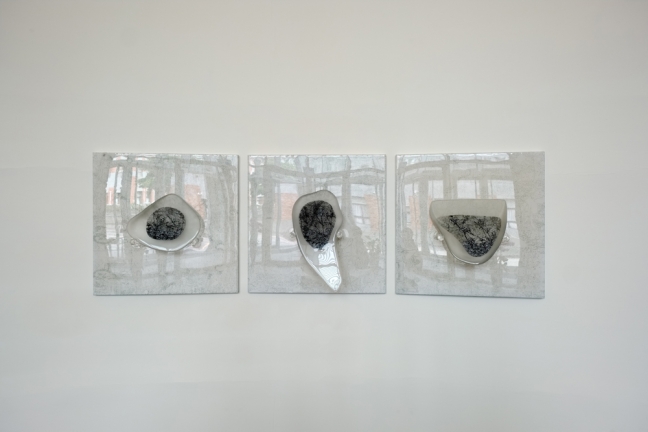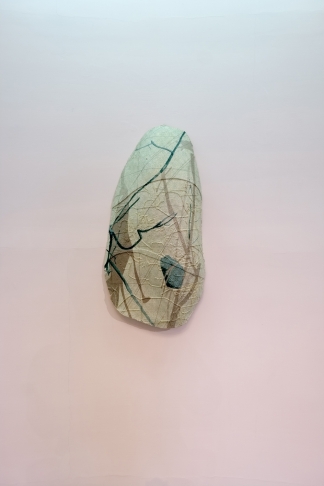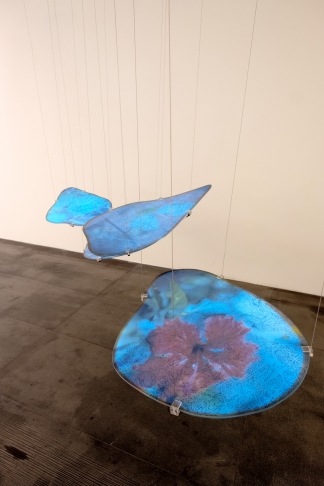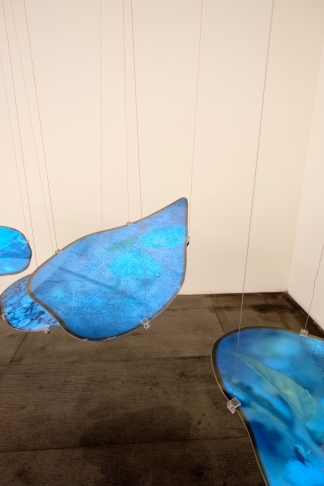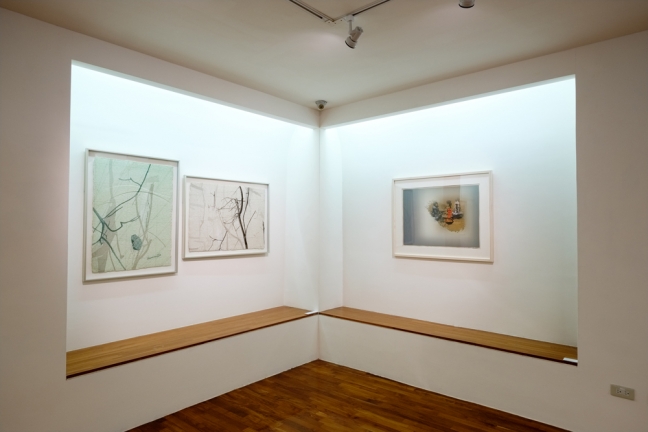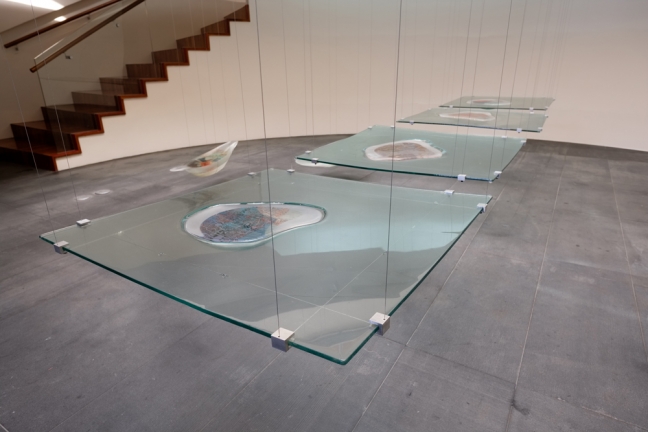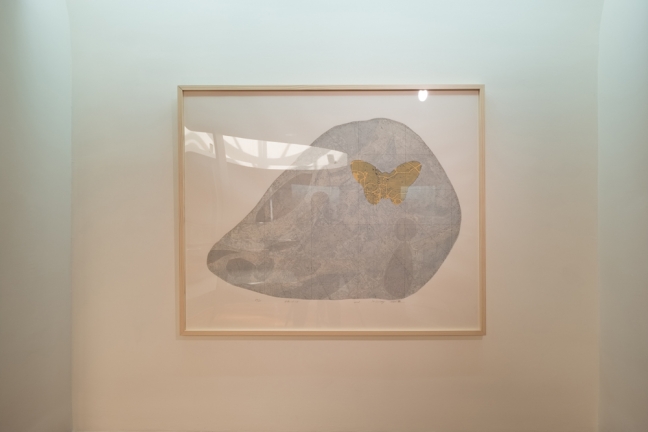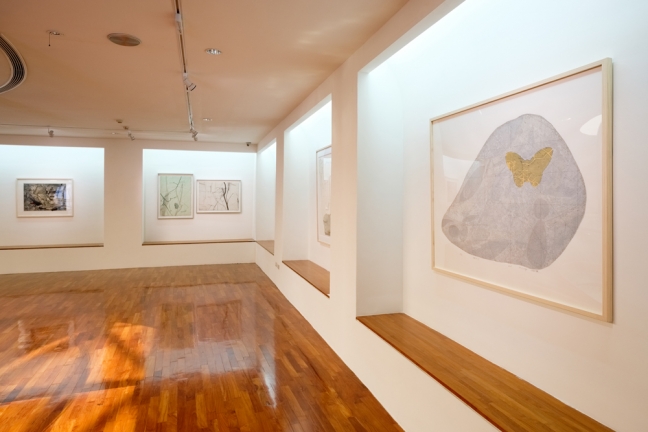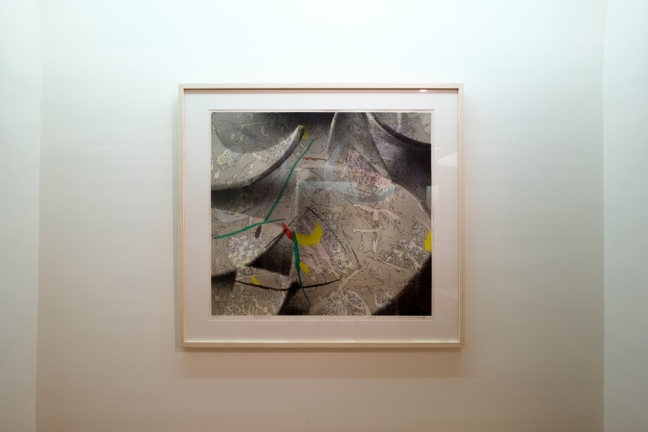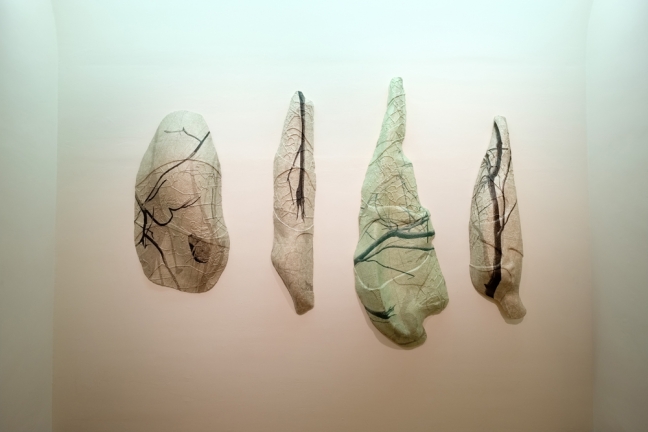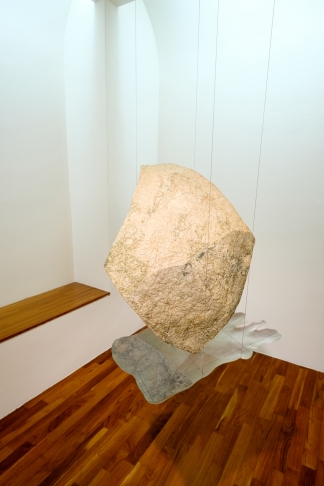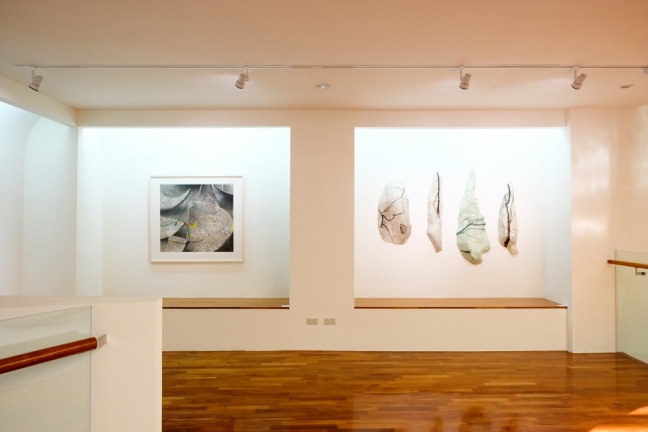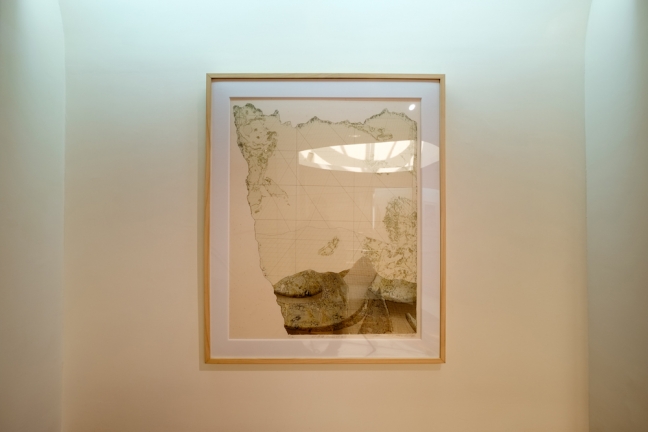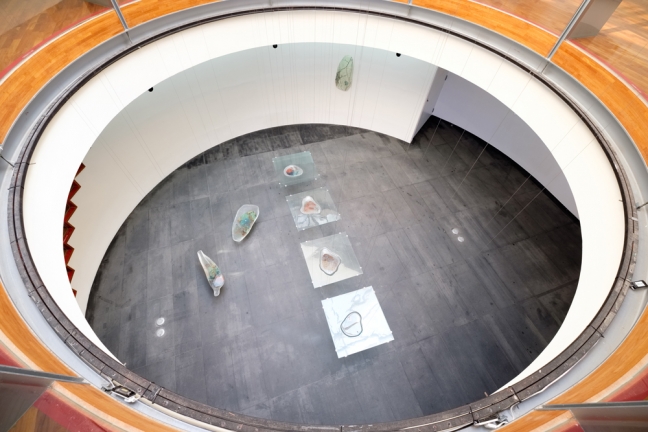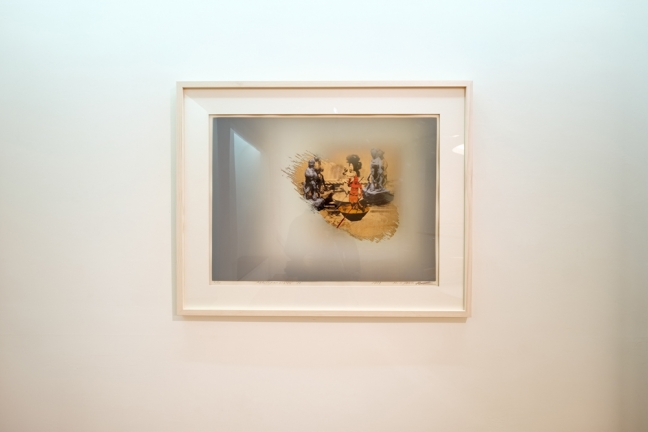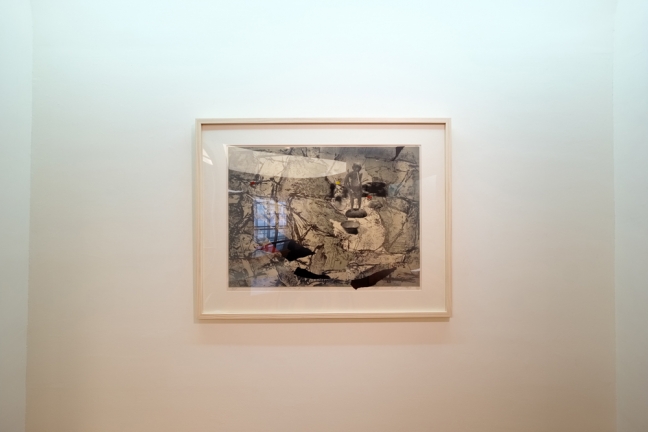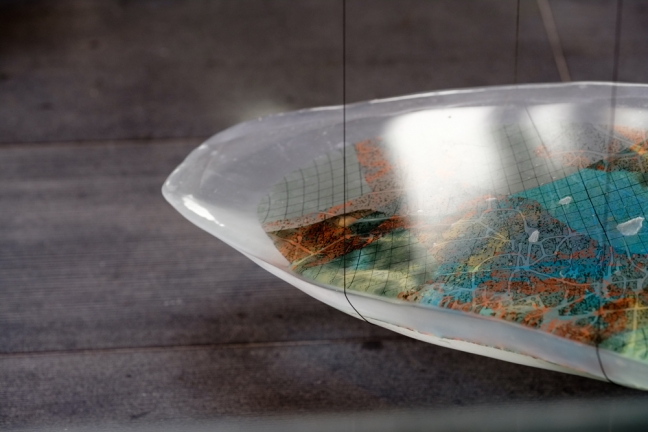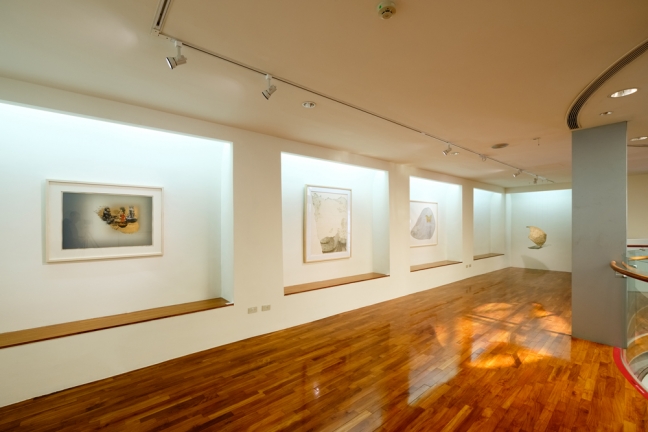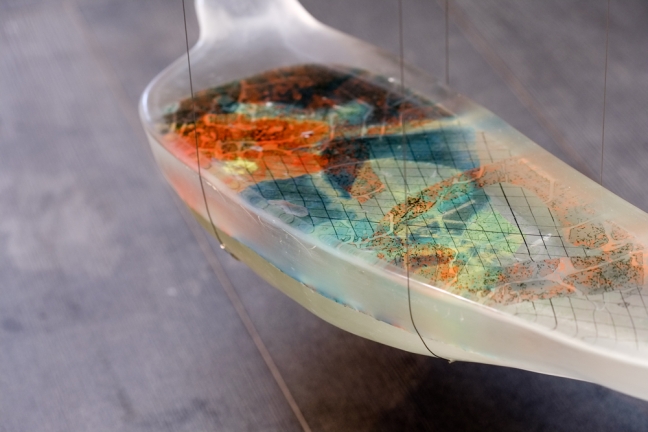The Print of Nature: A Solo Exhibition by Yang Ming-Dye
2018.03.09~2018.04.29
09:00 - 17:00
Yang Ming-Dye is a very important print artist in Taiwan. He adopts glass, silk and paper pulp as his major mediums for art creation and applies them to three-dimensional sculptures and installations. Though being widely celebrated, he remains humble and genuine. He has a gentle and affectionate temperament. Taking up his residence in Tainan, he lives a simple life and works hard on perfecting his mastery of printmaking at ease and in peace. Those who know the artist and his works well can see profound serenity in his mild and calm demeanor, while we can catch a glimpse of the same characteristics in his serene artworks. The first period of Yang Ming-Dye’s career as an artist is generally agreed to be the years before 1985. We may call this stage the Germination Period. During this phase, he adopted and displaced the photographed images of Taiwanese folk religions in his works. The representative works of this period include series like Real and Imaginary, Illusion, and Mountain Landscapes. The second phase of his career, as we may call the Condensation Period, was from 1985 to 1995. In this period, he used the abstract points, lines, and planes of the cadastral maps as art elements and made variations on them. The works were created in a free style that echoed the theme of nature. Important works during this time are The Pastoral Idyll, Legends, Trace and other series. It is in this period that Yang’s style was established. After he went to study in the US in 1995, Yang began to apply the techniques of printmaking to sculptures that were made of mediums such as paper, glass and mental. By displaying these works in a three-dimensional way, he made flat printing solid. The third phase is the Expansion Period, in which Yang combined mediums of different properties and used them to create works. Series like Dispersed Clouds and Clouds in the Water are the fruits produced in this period. In the recent years, in addition to his continuous efforts on multiple print installation, he has progressed into the Serenity Period. Simple lines and tranquil coloring have become important art elements in his works. The disposition to simplify lines and colors is especially obvious in Water Coat and Grass Coat. In these two series, it seems that Yang has turned back to the original two-dimensional art. In them, we observe a return to innocence, that is, an inclination to stay faithful to the initial resoluteness. To take a general view of the four periods aforesaid, we may conclude that the works of Yang Ming-Dye have gone beyond what is generally taken as prints and have crossed over into the fields of sculpture and installation. His achievement is extraordinary and his influence in printmaking in Taiwan is tremendous. He has indeed left a lasting imprint in the development of printmaking. The styles of his art correspond to his mind in different phases of life. Each period faithfully and warmly reflects the truth of life, and his art has become serene and tranquil with age. (Excerpted from
The Warm Glow of the Oil Lamp—On the Development of Yang Ming-Dye’s Art,” Ni Tsai-Chin)
The Warm Glow of the Oil Lamp—On the Development of Yang Ming-Dye’s Art,” Ni Tsai-Chin)
Yang Ming-Dye is a very important print artist in Taiwan. He adopts glass, silk and paper pulp as his major mediums for art creation and applies them to three-dimensional sculptures and installations. Though being widely celebrated, he remains humble and genuine. He has a gentle and affectionate temperament. Taking up his residence in Tainan, he lives a simple life and works hard on perfecting his mastery of printmaking at ease and in peace. Those who know the artist and his works well can see profound serenity in his mild and calm demeanor, while we can catch a glimpse of the same characteristics in his serene artworks. The first period of Yang Ming-Dye’s career as an artist is generally agreed to be the years before 1985. We may call this stage the Germination Period. During this phase, he adopted and displaced the photographed images of Taiwanese folk religions in his works. The representative works of this period include series like Real and Imaginary, Illusion, and Mountain Landscapes. The second phase of his career, as we may call the Condensation Period, was from 1985 to 1995. In this period, he used the abstract points, lines, and planes of the cadastral maps as art elements and made variations on them. The works were created in a free style that echoed the theme of nature. Important works during this time are The Pastoral Idyll, Legends, Trace and other series. It is in this period that Yang’s style was established. After he went to study in the US in 1995, Yang began to apply the techniques of printmaking to sculptures that were made of mediums such as paper, glass and mental. By displaying these works in a three-dimensional way, he made flat printing solid. The third phase is the Expansion Period, in which Yang combined mediums of different properties and used them to create works. Series like Dispersed Clouds and Clouds in the Water are the fruits produced in this period. In the recent years, in addition to his continuous efforts on multiple print installation, he has progressed into the Serenity Period. Simple lines and tranquil coloring have become important art elements in his works. The disposition to simplify lines and colors is especially obvious in Water Coat and Grass Coat. In these two series, it seems that Yang has turned back to the original two-dimensional art. In them, we observe a return to innocence, that is, an inclination to stay faithful to the initial resoluteness. To take a general view of the four periods aforesaid, we may conclude that the works of Yang Ming-Dye have gone beyond what is generally taken as prints and have crossed over into the fields of sculpture and installation. His achievement is extraordinary and his influence in printmaking in Taiwan is tremendous. He has indeed left a lasting imprint in the development of printmaking. The styles of his art correspond to his mind in different phases of life. Each period faithfully and warmly reflects the truth of life, and his art has become serene and tranquil with age. (Excerpted from
The Warm Glow of the Oil Lamp—On the Development of Yang Ming-Dye’s Art,” Ni Tsai-Chin)
The Warm Glow of the Oil Lamp—On the Development of Yang Ming-Dye’s Art,” Ni Tsai-Chin)
Born in 1955 in Tainan, Taiwan, Yang Ming-Dye graduated from National Academy of Arts in 1977 and obtained his MFA from State University of New York (SUNY) in 1998. He has taught at Graduate Institute of Plastic Arts at Tainan National University of the Arts, School of Fine Arts at Taipei National University of the Arts (TNUA), Master’s Program in Printmaking at National Taiwan University of Arts (NTUA), Department of Fine Arts at National University of Tainan, and Department of Fine Arts at National Chiayi University. He is currently the chair of Department of Fine Arts at National Kaohsiung Normal University (NKNU).
Yang won the Prize of the CCA Minister at the 2nd International Biennial Print Exhibit ROC (1985), the Award for Outstanding Artist at Taipei-Peking Graphic Exhibition (1990), the Gold Medal Award at the 5th International Biennial Print Exhibit ROC (1991), the Honorary Award at the 10th Norwegian International Print Triennial (1992), the 18th National Awards of Art (1993), the Honorary Award at the 2nd Egyptian International Print Triennale (1997), the Silver Medal Award at Late 20th Century Asian Arts Contest by the Asian Arts Council (1999), and the 14th Golden Seal Award from the Taiwan Society of Printmaking (2004). Solo Exhibitions (Selected) 37 Traces (Taipei Fine Arts Museum, 1994), Fragment (Art Gallery, SUNY School of the Arts, 1998), Clouds in the Water (National Central University Art Center, 2005), Prints in Three-dimension (Zhenshanmei Gallery, NTUA, 2009), Watermark (Licence Art Gallery, 2010), The Warm Glow of the Oil Lamp (Show Gallery, 2011), Water‧Light (116 Art Center at NKNU, 2014), Clouds in the Box (Inno Art, 2015), and Water Coat (Guangfu Art Center, Shanghai, 2017). Joint Exhibitions (Selected) Invitation Exhibition of Award-winning Artists of the International Biennial Print Exhibit ROC (Taipei Fine Arts Museum, 2001), International Invitation Exhibition of Prints (Musashino Art University, Japan, 2004), Macao International Exhibition of Prints (Macao Museum of Art, 2007), A Voice of Taiwan Art (O Art Museum, Tokyo, Japan, 2008), The Art at the Beginning of Century—Cross-Strait Paintings Joint Exhibition (National Dr. Sun Yat-sen Memorial Hall, 2009), 100 Paintings in 100 Years—Invitation Exhibition of Taiwan’s Modern Painters (National Dr. Sun Yat-sen Memorial Hall, 2011), SKY—2011 Asia Plate & Print Exhibition (Kuandu Museum of Fine Arts at TNUA, 2011), Asia Print Exhibition and the Progress in Taiwan Modern Printmaking (Pingtung Art Museum, 2013), Marvelous Encounters in the Collection (Kaohsiung Museum of Fine Arts, 2014), and The Marks of Time—Taiwan 1950s Modern Printmaking Series (ARKI GALÉRIA, 2015). Collection (Selected) Museum of Art, SUNY at New Paltz, Shanghai Art Museum, National Taiwan Museum of Fine Arts, Taipei Fine Arts Museum, Kaohsiung Museum of Fine Arts, Kuandu Museum of Fine Arts at TNUA, Tainan Art Museum, Chimei Museum, Taiwan National Exhibition Committee for Arts, International Printmaking Center at National Taiwan Normal University, and 116 Art Center at NKNU.
Yang won the Prize of the CCA Minister at the 2nd International Biennial Print Exhibit ROC (1985), the Award for Outstanding Artist at Taipei-Peking Graphic Exhibition (1990), the Gold Medal Award at the 5th International Biennial Print Exhibit ROC (1991), the Honorary Award at the 10th Norwegian International Print Triennial (1992), the 18th National Awards of Art (1993), the Honorary Award at the 2nd Egyptian International Print Triennale (1997), the Silver Medal Award at Late 20th Century Asian Arts Contest by the Asian Arts Council (1999), and the 14th Golden Seal Award from the Taiwan Society of Printmaking (2004). Solo Exhibitions (Selected) 37 Traces (Taipei Fine Arts Museum, 1994), Fragment (Art Gallery, SUNY School of the Arts, 1998), Clouds in the Water (National Central University Art Center, 2005), Prints in Three-dimension (Zhenshanmei Gallery, NTUA, 2009), Watermark (Licence Art Gallery, 2010), The Warm Glow of the Oil Lamp (Show Gallery, 2011), Water‧Light (116 Art Center at NKNU, 2014), Clouds in the Box (Inno Art, 2015), and Water Coat (Guangfu Art Center, Shanghai, 2017). Joint Exhibitions (Selected) Invitation Exhibition of Award-winning Artists of the International Biennial Print Exhibit ROC (Taipei Fine Arts Museum, 2001), International Invitation Exhibition of Prints (Musashino Art University, Japan, 2004), Macao International Exhibition of Prints (Macao Museum of Art, 2007), A Voice of Taiwan Art (O Art Museum, Tokyo, Japan, 2008), The Art at the Beginning of Century—Cross-Strait Paintings Joint Exhibition (National Dr. Sun Yat-sen Memorial Hall, 2009), 100 Paintings in 100 Years—Invitation Exhibition of Taiwan’s Modern Painters (National Dr. Sun Yat-sen Memorial Hall, 2011), SKY—2011 Asia Plate & Print Exhibition (Kuandu Museum of Fine Arts at TNUA, 2011), Asia Print Exhibition and the Progress in Taiwan Modern Printmaking (Pingtung Art Museum, 2013), Marvelous Encounters in the Collection (Kaohsiung Museum of Fine Arts, 2014), and The Marks of Time—Taiwan 1950s Modern Printmaking Series (ARKI GALÉRIA, 2015). Collection (Selected) Museum of Art, SUNY at New Paltz, Shanghai Art Museum, National Taiwan Museum of Fine Arts, Taipei Fine Arts Museum, Kaohsiung Museum of Fine Arts, Kuandu Museum of Fine Arts at TNUA, Tainan Art Museum, Chimei Museum, Taiwan National Exhibition Committee for Arts, International Printmaking Center at National Taiwan Normal University, and 116 Art Center at NKNU.
Born in 1955 in Tainan, Taiwan, Yang Ming-Dye graduated from National Academy of Arts in 1977 and obtained his MFA from State University of New York (SUNY) in 1998. He has taught at Graduate Institute of Plastic Arts at Tainan National University of the Arts, School of Fine Arts at Taipei National University of the Arts (TNUA), Master’s Program in Printmaking at National Taiwan University of Arts (NTUA), Department of Fine Arts at National University of Tainan, and Department of Fine Arts at National Chiayi University. He is currently the chair of Department of Fine Arts at National Kaohsiung Normal University (NKNU).
Yang won the Prize of the CCA Minister at the 2nd International Biennial Print Exhibit ROC (1985), the Award for Outstanding Artist at Taipei-Peking Graphic Exhibition (1990), the Gold Medal Award at the 5th International Biennial Print Exhibit ROC (1991), the Honorary Award at the 10th Norwegian International Print Triennial (1992), the 18th National Awards of Art (1993), the Honorary Award at the 2nd Egyptian International Print Triennale (1997), the Silver Medal Award at Late 20th Century Asian Arts Contest by the Asian Arts Council (1999), and the 14th Golden Seal Award from the Taiwan Society of Printmaking (2004). Solo Exhibitions (Selected) 37 Traces (Taipei Fine Arts Museum, 1994), Fragment (Art Gallery, SUNY School of the Arts, 1998), Clouds in the Water (National Central University Art Center, 2005), Prints in Three-dimension (Zhenshanmei Gallery, NTUA, 2009), Watermark (Licence Art Gallery, 2010), The Warm Glow of the Oil Lamp (Show Gallery, 2011), Water‧Light (116 Art Center at NKNU, 2014), Clouds in the Box (Inno Art, 2015), and Water Coat (Guangfu Art Center, Shanghai, 2017). Joint Exhibitions (Selected) Invitation Exhibition of Award-winning Artists of the International Biennial Print Exhibit ROC (Taipei Fine Arts Museum, 2001), International Invitation Exhibition of Prints (Musashino Art University, Japan, 2004), Macao International Exhibition of Prints (Macao Museum of Art, 2007), A Voice of Taiwan Art (O Art Museum, Tokyo, Japan, 2008), The Art at the Beginning of Century—Cross-Strait Paintings Joint Exhibition (National Dr. Sun Yat-sen Memorial Hall, 2009), 100 Paintings in 100 Years—Invitation Exhibition of Taiwan’s Modern Painters (National Dr. Sun Yat-sen Memorial Hall, 2011), SKY—2011 Asia Plate & Print Exhibition (Kuandu Museum of Fine Arts at TNUA, 2011), Asia Print Exhibition and the Progress in Taiwan Modern Printmaking (Pingtung Art Museum, 2013), Marvelous Encounters in the Collection (Kaohsiung Museum of Fine Arts, 2014), and The Marks of Time—Taiwan 1950s Modern Printmaking Series (ARKI GALÉRIA, 2015). Collection (Selected) Museum of Art, SUNY at New Paltz, Shanghai Art Museum, National Taiwan Museum of Fine Arts, Taipei Fine Arts Museum, Kaohsiung Museum of Fine Arts, Kuandu Museum of Fine Arts at TNUA, Tainan Art Museum, Chimei Museum, Taiwan National Exhibition Committee for Arts, International Printmaking Center at National Taiwan Normal University, and 116 Art Center at NKNU.
Yang won the Prize of the CCA Minister at the 2nd International Biennial Print Exhibit ROC (1985), the Award for Outstanding Artist at Taipei-Peking Graphic Exhibition (1990), the Gold Medal Award at the 5th International Biennial Print Exhibit ROC (1991), the Honorary Award at the 10th Norwegian International Print Triennial (1992), the 18th National Awards of Art (1993), the Honorary Award at the 2nd Egyptian International Print Triennale (1997), the Silver Medal Award at Late 20th Century Asian Arts Contest by the Asian Arts Council (1999), and the 14th Golden Seal Award from the Taiwan Society of Printmaking (2004). Solo Exhibitions (Selected) 37 Traces (Taipei Fine Arts Museum, 1994), Fragment (Art Gallery, SUNY School of the Arts, 1998), Clouds in the Water (National Central University Art Center, 2005), Prints in Three-dimension (Zhenshanmei Gallery, NTUA, 2009), Watermark (Licence Art Gallery, 2010), The Warm Glow of the Oil Lamp (Show Gallery, 2011), Water‧Light (116 Art Center at NKNU, 2014), Clouds in the Box (Inno Art, 2015), and Water Coat (Guangfu Art Center, Shanghai, 2017). Joint Exhibitions (Selected) Invitation Exhibition of Award-winning Artists of the International Biennial Print Exhibit ROC (Taipei Fine Arts Museum, 2001), International Invitation Exhibition of Prints (Musashino Art University, Japan, 2004), Macao International Exhibition of Prints (Macao Museum of Art, 2007), A Voice of Taiwan Art (O Art Museum, Tokyo, Japan, 2008), The Art at the Beginning of Century—Cross-Strait Paintings Joint Exhibition (National Dr. Sun Yat-sen Memorial Hall, 2009), 100 Paintings in 100 Years—Invitation Exhibition of Taiwan’s Modern Painters (National Dr. Sun Yat-sen Memorial Hall, 2011), SKY—2011 Asia Plate & Print Exhibition (Kuandu Museum of Fine Arts at TNUA, 2011), Asia Print Exhibition and the Progress in Taiwan Modern Printmaking (Pingtung Art Museum, 2013), Marvelous Encounters in the Collection (Kaohsiung Museum of Fine Arts, 2014), and The Marks of Time—Taiwan 1950s Modern Printmaking Series (ARKI GALÉRIA, 2015). Collection (Selected) Museum of Art, SUNY at New Paltz, Shanghai Art Museum, National Taiwan Museum of Fine Arts, Taipei Fine Arts Museum, Kaohsiung Museum of Fine Arts, Kuandu Museum of Fine Arts at TNUA, Tainan Art Museum, Chimei Museum, Taiwan National Exhibition Committee for Arts, International Printmaking Center at National Taiwan Normal University, and 116 Art Center at NKNU.
by Chang Li-Hao . . . so much relief, so velvety a bloom in the restfulness of their somber and happy mass that in truth those large and leafy shadows which lay reflected on that lake of sunshine seemed aware that they were pledges of happiness and peace of mind. Marcel Proust, In Search of Lost Time: Book I Today, our society has entered an entirely digital era. Such a fact leads many people to the belief that changes in the real world become so fast that they are getting imperceptible and intangible. Yet, if we pay a little more attention and slow down our pace, we will find that there are things in our life steadily moving in their usual rhythm, such as the natural succession of the four seasons and the memories kept deep within the corner of the mind. It is as if we are situated in a time fissure that is simultaneously fast and slow. This fissure provides us completely different views and landscapes, whose beauty entices us to revisit them again and again . . . . Proust takes down the details of whatever happened in his life and renders them in a graceful and elegant language. However, the words he writes down are less a simple record of life than an opaque veil spun by poetic language that covers the reality. Only when the veil is lifted by a mild and gentle breeze can we glimpse a corner of what is concealed underneath. The veiled part lures us into a wondering in a labyrinth of words in which we tread on the paths that are both strange and familiar to us. Yang Ming-Dye, likewise, is cognizant that nature is full of wonder. It is obvious that he expresses what he thinks and feels by making use of different media in his artworks. It is equally clear that the utility of different of media shows him secret paths on which he sets out to explore the immanence and eternity of nature. On appreciating his artworks, the viewers are inspired and are able to see them from their own perspective a wholly new world that is at one with time and their mind. The Print of Nature covers Yang Ming-Dye’s artworks of different phases. We may well say that the exhibition is the epitome of Yang Ming-Dye’s artistic creations over the past three decades. Starting with Illusion, a series created in 1985, we trace the path that Yang walked on in the past thirty years, observing the development of his art through the exhibited artworks, which include series like Clouds in Water, Grass Coat, and his recent work Water Coat. It is not surprising that we do not find linear ruptures between successive series. Instead, between them appears a kind of link that approximates closer to a syncopation in music which is designed to make a tune offbeat. Such a syncopation-like feature renders his artworks an organic life form. The artworks made of incompatible media like glass, silk and pulp become three-dimensional and turn to be a living organism. Moreover, they undermine the concept of printing as a flat form of presentation and evoke a reflection on the essence of things. Having glass or metal of cool colors as the base, in Clouds in Water, for example, Yang Ming-Dye conjoins transient natural phenomena with personal emotions. Clouds accordingly become the reservoir of fragmented memories. The series reveals a sensory resonance between softness and hardness as well as dissolution and appearance. It also evokes possible imaginations about how people yearn for the lost memories—an island that has never existed in reality, the scattered shadows of the clouds that float by, an apparently old map with hidden secret codes and directions . . .. In a somehow obscure way, the artworks let the viewers’ imagination run riot and make them realize that the beauty of life lies in the landscapes that we see and imagine. In spite of the fact that Water Coat and Grass Coat were created in different phases, both of them imply a philosophical idea of Zen, that is, the Way is like “clouds in the blue sky and water in a vase.” Returning to the basic concept of two-dimensional art, Yang Ming-Dye uses the simplest lines and colors to compose irregular shapes. In a casual way, he catches “the ever and ever prolonging moment in the here and now” by mixing what he sees in particular moments with memories that are brought back from the past. The viewers undoubtedly can distinguish readily in his artworks natural images such as swimming fish, flying birds and butterflies, the flowers field that are in bloom, and layers and layers of mountain far away. These natural images are not the products of a rational treatment like specimen making; nor are they a logical necessity resulting from a cause and effect relationship. They are instead representations of the true nature of things. Being true and illusory at the same time, they are like transparent crystal that shines in splendor when it reflects the light. The boundaries between the true and illusory dissolve and we can no longer tell one from the other. In brief, the artworks exhibited in The Print of Nature give the viewers hints on multiple narrow winding trails leading to a place full of unknown surprises rather than a route map showing the way to a specific destination. Moreover, when seeing them, we feel like walking alone in the street late at night. There are houses along the street. Some of which are well-lit, and we can see clearly what people are doing through the windows. Yet, we cannot hear clearly what they are talking to each other. Like a theater that shows on stage scenarios without clear plots and sufficient details, such a scene is acted and re-acted out in front of us. All the moments we experience condense into words pregnant with symbolic meanings. In the end, as the camera zoom out, you and I in the light may walk on a different way; and yet we remain in the same peaceful and tranquil landscape. We linger on and on, unwilling to say goodbye, as we know this is where peace and happiness resides.
by Chang Li-Hao . . . so much relief, so velvety a bloom in the restfulness of their somber and happy mass that in truth those large and leafy shadows which lay reflected on that lake of sunshine seemed aware that they were pledges of happiness and peace of mind. Marcel Proust, In Search of Lost Time: Book I Today, our society has entered an entirely digital era. Such a fact leads many people to the belief that changes in the real world become so fast that they are getting imperceptible and intangible. Yet, if we pay a little more attention and slow down our pace, we will find that there are things in our life steadily moving in their usual rhythm, such as the natural succession of the four seasons and the memories kept deep within the corner of the mind. It is as if we are situated in a time fissure that is simultaneously fast and slow. This fissure provides us completely different views and landscapes, whose beauty entices us to revisit them again and again . . . . Proust takes down the details of whatever happened in his life and renders them in a graceful and elegant language. However, the words he writes down are less a simple record of life than an opaque veil spun by poetic language that covers the reality. Only when the veil is lifted by a mild and gentle breeze can we glimpse a corner of what is concealed underneath. The veiled part lures us into a wondering in a labyrinth of words in which we tread on the paths that are both strange and familiar to us. Yang Ming-Dye, likewise, is cognizant that nature is full of wonder. It is obvious that he expresses what he thinks and feels by making use of different media in his artworks. It is equally clear that the utility of different of media shows him secret paths on which he sets out to explore the immanence and eternity of nature. On appreciating his artworks, the viewers are inspired and are able to see them from their own perspective a wholly new world that is at one with time and their mind. The Print of Nature covers Yang Ming-Dye’s artworks of different phases. We may well say that the exhibition is the epitome of Yang Ming-Dye’s artistic creations over the past three decades. Starting with Illusion, a series created in 1985, we trace the path that Yang walked on in the past thirty years, observing the development of his art through the exhibited artworks, which include series like Clouds in Water, Grass Coat, and his recent work Water Coat. It is not surprising that we do not find linear ruptures between successive series. Instead, between them appears a kind of link that approximates closer to a syncopation in music which is designed to make a tune offbeat. Such a syncopation-like feature renders his artworks an organic life form. The artworks made of incompatible media like glass, silk and pulp become three-dimensional and turn to be a living organism. Moreover, they undermine the concept of printing as a flat form of presentation and evoke a reflection on the essence of things. Having glass or metal of cool colors as the base, in Clouds in Water, for example, Yang Ming-Dye conjoins transient natural phenomena with personal emotions. Clouds accordingly become the reservoir of fragmented memories. The series reveals a sensory resonance between softness and hardness as well as dissolution and appearance. It also evokes possible imaginations about how people yearn for the lost memories—an island that has never existed in reality, the scattered shadows of the clouds that float by, an apparently old map with hidden secret codes and directions . . .. In a somehow obscure way, the artworks let the viewers’ imagination run riot and make them realize that the beauty of life lies in the landscapes that we see and imagine. In spite of the fact that Water Coat and Grass Coat were created in different phases, both of them imply a philosophical idea of Zen, that is, the Way is like “clouds in the blue sky and water in a vase.” Returning to the basic concept of two-dimensional art, Yang Ming-Dye uses the simplest lines and colors to compose irregular shapes. In a casual way, he catches “the ever and ever prolonging moment in the here and now” by mixing what he sees in particular moments with memories that are brought back from the past. The viewers undoubtedly can distinguish readily in his artworks natural images such as swimming fish, flying birds and butterflies, the flowers field that are in bloom, and layers and layers of mountain far away. These natural images are not the products of a rational treatment like specimen making; nor are they a logical necessity resulting from a cause and effect relationship. They are instead representations of the true nature of things. Being true and illusory at the same time, they are like transparent crystal that shines in splendor when it reflects the light. The boundaries between the true and illusory dissolve and we can no longer tell one from the other. In brief, the artworks exhibited in The Print of Nature give the viewers hints on multiple narrow winding trails leading to a place full of unknown surprises rather than a route map showing the way to a specific destination. Moreover, when seeing them, we feel like walking alone in the street late at night. There are houses along the street. Some of which are well-lit, and we can see clearly what people are doing through the windows. Yet, we cannot hear clearly what they are talking to each other. Like a theater that shows on stage scenarios without clear plots and sufficient details, such a scene is acted and re-acted out in front of us. All the moments we experience condense into words pregnant with symbolic meanings. In the end, as the camera zoom out, you and I in the light may walk on a different way; and yet we remain in the same peaceful and tranquil landscape. We linger on and on, unwilling to say goodbye, as we know this is where peace and happiness resides.
